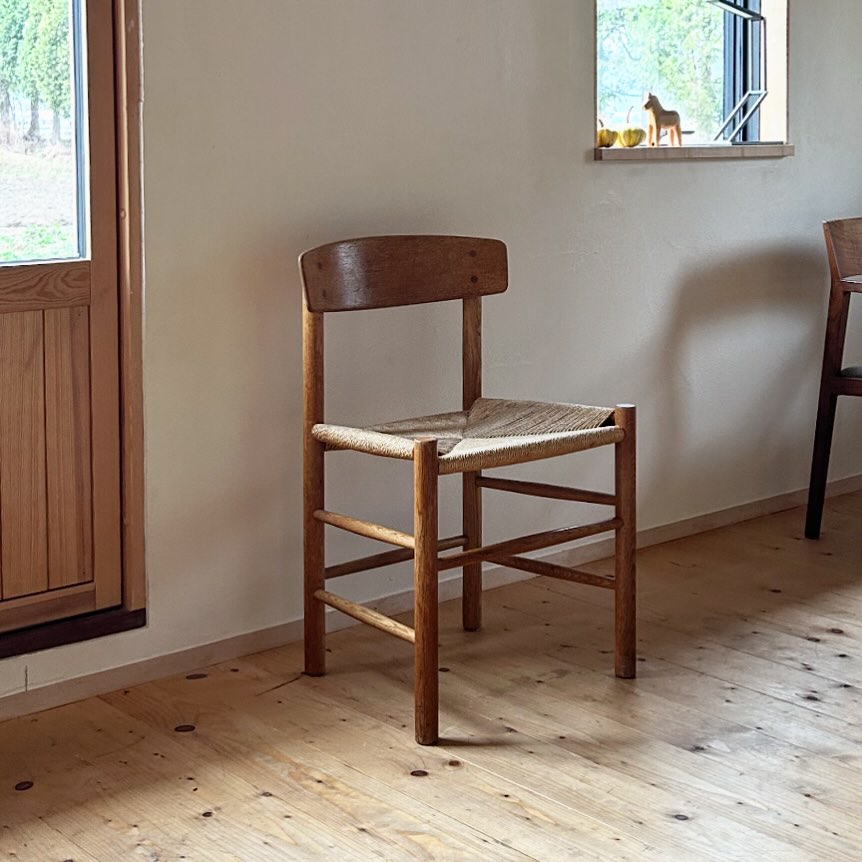2024.4.14
J39
4月18日、「東川町よい椅子の日」のデザインスクールで椅子についてのトークイベントに参加する機会があった。世界的な家具の研究家である織田憲嗣先生の1300点を超える膨大な椅子のコレクションの中から、ひとつの椅子を選んで紹介するという企画であった。東川町内で椅子をデザインする6名のデザイナーと木工家がそれぞれの選んだ椅子について話をした。
私は迷うことなくボーエ・モーエンセンのJ39を選んだ。通称People’s chair(市民の椅子)と呼ばれる椅子は、1947年にデンマークのFDB(生活協同組合)が全ての人々のために適正な価格で品質の高い椅子を届けるというコンセプトの元につくられた椅子である。初めてデンマークのコペンハーゲンを訪れた時、チボリ公園そばのカフェに無造作に並べられたJ39を見て、その椅子にコペンハーゲンの人たちが座る姿を見て、まさに市民の椅子だと感激したのを覚えている。
シェカーチェアとも呼ばれるJ39は北米シェカー教徒の伝統的な椅子のリデザインである。モーエンセンの師であるコーア・クリントも教会のための椅子としてシェーカー・チェアのリデザインをしており、J39はコーア・クリントの椅子のリデザインとも考えられる。J39はシェーカー・チェア同様、ほぼ直線だけで構成されているが、座面のペーパーコードを受ける貫に膨らみがあり、そのわずかな曲線が全体の印象をシェーカー・チェアと比べると、柔らかい雰囲気にしているように思う。
私にとって織田コレクションのデザイナーの中で常に手本としているのは、ボーエ・モーエンセンである。ハンス・ウェグナーやフィン・ユールも大好きではあるが、彼らの自由で有機的な線を用いたデザインは、自分には到底真似のできないデザインである。定規で引ける直線の構成と、ほんの少しの曲線だけで構成するモーエンセンのデザインは、自分でもできるような錯覚を抱かせてくれるのである。直線の長さの比率を考えたり、各部の位置を移動したり、角度を変えたり、かたちをこねくり回すことでしか、私はデザインができないのである。しかし実際には、単純な要素の構成だけでモーエンセンのような美しいものを生み出すのは、ほとんど不可能なことのように思えてくる…。
今回のトークイベントのための椅子の選定の際に、他の参加者と椅子が被ってしまった時のために、第3候補まで選ぶことになっていた。私は第2候補にトーネットのNo.14、第3候補にカール・マルムステンのリラ・オーランドという椅子を選んでいた。トーネットのNo.14は言わずと知れた、モダンデザインを代表する椅子で、おそらくは世界で最も多くつくられている椅子である。パリのカフェのテラス席に並んでいる姿を誰もが見たことがあるのではないだろうか。リラ・オーランドはマルムステンの家具としては珍しく、量産を考慮したデザインのウィンザーチェアである。スウェーデンのカペラゴーデンがある田舎の集落では、たくさんの家にこの椅子があり、滞在中に何脚もこの椅子の外れたスピンドルを直した記憶が蘇る。
私は結果的に3つとも庶民の椅子を選んでいたのである。
20世紀は産業革命と民主主義、そして資本主義によって、それまでは王様や貴族の権威の象徴であった椅子が、市民の椅子となった時代とも言えるのではないかと思う。モダンデザインの目指した最も大きな物語は、「よいデザインのものをより多くの人々に届ける」ということであったのではないだろうか。IKEAの理念が、デモクラティック・デザイン(デザインの民主化)、「より快適な毎日を、より多くの方々に」であることはそのことを象徴している。そして、その物語は先進国においてはほぼ達成し、量においては自動車、家電、スマートフォン、生活道具などはほとんど全ての人に行き渡っている。おそらく、家具はすでに人間が必要な数以上につくられてしまっているのではないか、と思う。
21世紀に入り、前世紀の過剰な生産活動や過剰な資本主義の膨張により、気候変動はますます大きくなり、社会的には格差がますます拡大している。私たちの抱える問題は足りないものをどうやってつくるのかではなく、つくり過ぎている現状をどうやって是正するのか?、大きくなり過ぎた資本主義をどうやって適正なサイズにしていくのか?、であり、その問題に対する新たな物語を描かないといけないのではないだろうか?
私はただ家具をつくりたいだけなのではあるが…つくろうとしている家具がほんとうに必要な家具なのか、どのような物語の中でつくられているのか、常に自問自答しながらつくっていきたい。
J39
On April 18th, I had the opportunity to participate in a talk event about chairs at a design school on "Higashikawa Good Chair Day". The project was to select and introduce one chair from the collection of over 1,300 chairs collected by Noritsugu Oda, a world-renowned furniture researcher. Six designers and woodworkers who design chairs in Higashikawa Town talked about the chairs they had chosen.
I chose Børge Mogensen's J39 without hesitation. The chair, commonly known as the People's Chair, was created in 1947 by the Danish FDB (consumer's cooperative) based on the concept of delivering high-quality chairs at a fair price for everyone. When I first visited Copenhagen, Denmark, I saw J39s casually lined up in a cafe near Tivoli Gardens, and when I saw the people of Copenhagen sitting on those chairs, I remember being moved by the fact that they were truly citizen's chairs.
The J39, also known as Shaker chair, is a redesign of the traditional chair of the Shaker people of North America. Mogensen's teacher, Kaare Klint, also redesigned the Shaker chair as a church chair, and the J39 can also be thought of as a redesign of Kaare Klint's chair. Like the Shaker chair, J39 is made up of almost straight lines, but there is a bulge in the spindle that receives the paper cord on the seat, and I think the slight curve gives the overall impression a softer feel compared to the Shaker chair.
Among the Oda Collection designers, Børge Mogensen has always been my role model. I also love Hans Wegner and Finn Juhl, but their free and organic line designs are something I would never be able to model. Mogensen's designs, which consist of straight lines that can be drawn with a ruler and only a few curved lines, give the illusion that I also can do. I can only create designs by thinking about the ratio of the length of straight lines, moving the position of each part, changing the angle, and twisting the shape. However, in reality, it seems almost impossible to create something as beautiful as Mogensen's with just a simple composition of elements...
When selecting chairs for this talk event, I had decided to choose up to a third choice in case my chair overlapped with another participant's. My second choice was Thonet's No.14, and my third choice was Carl Malmsten's Lilla Åland. Thonet No.14 is a chair that represents modern design, and is probably the most produced chair in the world. I'm sure everyone has seen them lined up on terrace seats at cafes in Paris. Lilla Åland is a Windsor chair that was designed with mass production in mind, which is unusual for Malmsten furniture. In the rural village of Capellagården in Sweden, many homes had this chair, and I have fond memories of fixing the spindles on many of these chairs during my stay there.
I chose common people's chairs for all three.
I think the 20th century can be said to be a time when the industrial revolution, democracy, and capitalism changed the chair, which had previously been a symbol of the authority of kings and aristocrats, to become the chair of citizens. Perhaps the biggest story behind modern design was to "deliver good design to as many people as possible." This story has almost been achieved in developed countries, and in terms of quantity, cars, home appliances, smartphones, and everyday tools have become available to almost everyone. I think that more furniture has already been produced than is needed by humans.
In the 21st century, climate change is becoming more severe and social disparities are widening due to the excessive production activities and excessive expansion of capitalism of the last century. The problem we face is not how to create what we don't have, but how to correct the current situation where we create too much, how do we bring capitalism to an appropriate size when it has grown too large. We have to draw a new big story to deal with these problem.
I just want to make furniture... but I want to always ask myself questions about whether the furniture I'm trying to make is really necessary, and what kind of story it's being made in.

